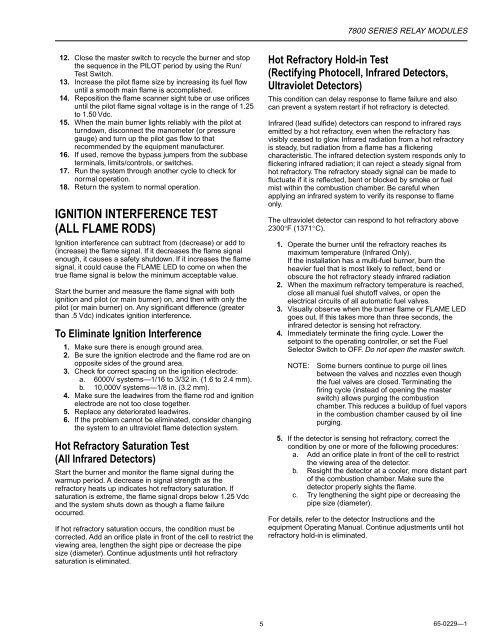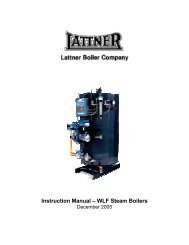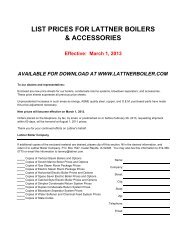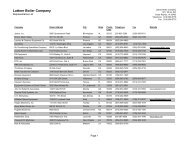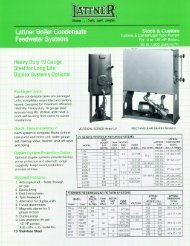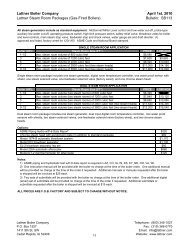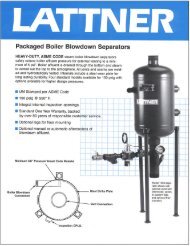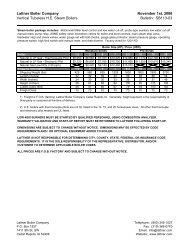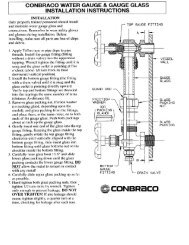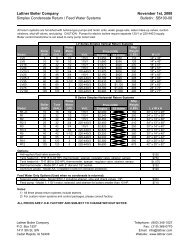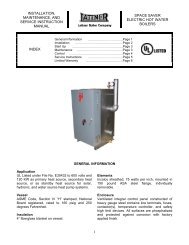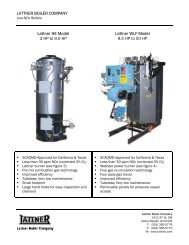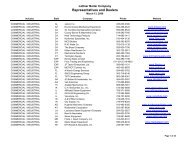65-0229 - 7800 SERIES Relay Modules - Greenheck
65-0229 - 7800 SERIES Relay Modules - Greenheck
65-0229 - 7800 SERIES Relay Modules - Greenheck
Create successful ePaper yourself
Turn your PDF publications into a flip-book with our unique Google optimized e-Paper software.
12. Close the master switch to recycle the burner and stop<br />
the sequence in the PILOT period by using the Run/<br />
Test Switch.<br />
13. Increase the pilot flame size by increasing its fuel flow<br />
until a smooth main flame is accomplished.<br />
14. Reposition the flame scanner sight tube or use orifices<br />
until the pilot flame signal voltage is in the range of 1.25<br />
to 1.50 Vdc.<br />
15. When the main burner lights reliably with the pilot at<br />
turndown, disconnect the manometer (or pressure<br />
gauge) and turn up the pilot gas flow to that<br />
recommended by the equipment manufacturer.<br />
16. If used, remove the bypass jumpers from the subbase<br />
terminals, limits/controls, or switches.<br />
17. Run the system through another cycle to check for<br />
normal operation.<br />
18. Return the system to normal operation.<br />
IGNITION INTERFERENCE TEST<br />
(ALL FLAME RODS)<br />
Ignition interference can subtract from (decrease) or add to<br />
(increase) the flame signal. If it decreases the flame signal<br />
enough, it causes a safety shutdown. If it increases the flame<br />
signal, it could cause the FLAME LED to come on when the<br />
true flame signal is below the minimum acceptable value.<br />
Start the burner and measure the flame signal with both<br />
ignition and pilot (or main burner) on, and then with only the<br />
pilot (or main burner) on. Any significant difference (greater<br />
than .5 Vdc) indicates ignition interference.<br />
To Eliminate Ignition Interference<br />
1. Make sure there is enough ground area.<br />
2. Be sure the ignition electrode and the flame rod are on<br />
opposite sides of the ground area.<br />
3. Check for correct spacing on the ignition electrode:<br />
a. 6000V systems—1/16 to 3/32 in. (1.6 to 2.4 mm).<br />
b. 10,000V systems—1/8 in. (3.2 mm).<br />
4. Make sure the leadwires from the flame rod and ignition<br />
electrode are not too close together.<br />
5. Replace any deteriorated leadwires.<br />
6. If the problem cannot be eliminated, consider changing<br />
the system to an ultraviolet flame detection system.<br />
Hot Refractory Saturation Test<br />
(All Infrared Detectors)<br />
Start the burner and monitor the flame signal during the<br />
warmup period. A decrease in signal strength as the<br />
refractory heats up indicates hot refractory saturation. If<br />
saturation is extreme, the flame signal drops below 1.25 Vdc<br />
and the system shuts down as though a flame failure<br />
occurred.<br />
If hot refractory saturation occurs, the condition must be<br />
corrected. Add an orifice plate in front of the cell to restrict the<br />
viewing area, lengthen the sight pipe or decrease the pipe<br />
size (diameter). Continue adjustments until hot refractory<br />
saturation is eliminated.<br />
<strong>7800</strong> <strong>SERIES</strong> RELAY MODULES<br />
Hot Refractory Hold-in Test<br />
(Rectifying Photocell, Infrared Detectors,<br />
Ultraviolet Detectors)<br />
This condition can delay response to flame failure and also<br />
can prevent a system restart if hot refractory is detected.<br />
Infrared (lead sulfide) detectors can respond to infrared rays<br />
emitted by a hot refractory, even when the refractory has<br />
visibly ceased to glow. Infrared radiation from a hot refractory<br />
is steady, but radiation from a flame has a flickering<br />
characteristic. The infrared detection system responds only to<br />
flickering infrared radiation; it can reject a steady signal from<br />
hot refractory. The refractory steady signal can be made to<br />
fluctuate if it is reflected, bent or blocked by smoke or fuel<br />
mist within the combustion chamber. Be careful when<br />
applying an infrared system to verify its response to flame<br />
only.<br />
The ultraviolet detector can respond to hot refractory above<br />
2300°F (1371°C).<br />
1. Operate the burner until the refractory reaches its<br />
maximum temperature (Infrared Only).<br />
If the installation has a multi-fuel burner, burn the<br />
heavier fuel that is most likely to reflect, bend or<br />
obscure the hot refractory steady infrared radiation<br />
2. When the maximum refractory temperature is reached,<br />
close all manual fuel shutoff valves, or open the<br />
electrical circuits of all automatic fuel valves.<br />
3. Visually observe when the burner flame or FLAME LED<br />
goes out. If this takes more than three seconds, the<br />
infrared detector is sensing hot refractory.<br />
4. Immediately terminate the firing cycle. Lower the<br />
setpoint to the operating controller, or set the Fuel<br />
Selector Switch to OFF. Do not open the master switch.<br />
NOTE: Some burners continue to purge oil lines<br />
between the valves and nozzles even though<br />
the fuel valves are closed. Terminating the<br />
firing cycle (instead of opening the master<br />
switch) allows purging the combustion<br />
chamber. This reduces a buildup of fuel vapors<br />
in the combustion chamber caused by oil line<br />
purging.<br />
5. If the detector is sensing hot refractory, correct the<br />
condition by one or more of the following procedures:<br />
a. Add an orifice plate in front of the cell to restrict<br />
the viewing area of the detector.<br />
b. Resight the detector at a cooler, more distant part<br />
of the combustion chamber. Make sure the<br />
detector properly sights the flame.<br />
c. Try lengthening the sight pipe or decreasing the<br />
pipe size (diameter).<br />
For details, refer to the detector Instructions and the<br />
equipment Operating Manual. Continue adjustments until hot<br />
refractory hold-in is eliminated.<br />
5 <strong>65</strong>-<strong>0229</strong>—1


